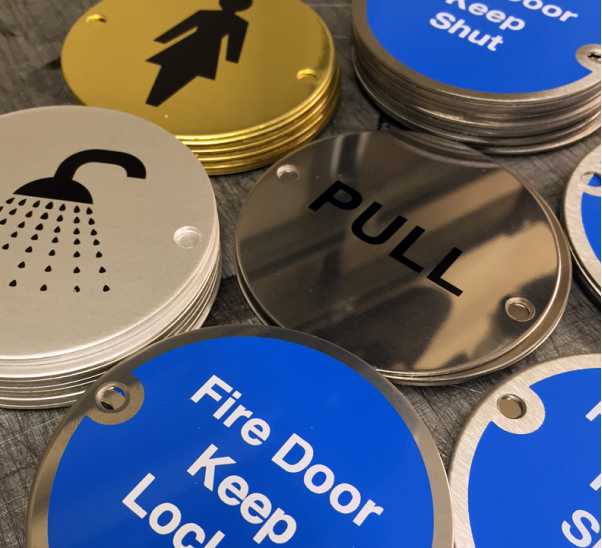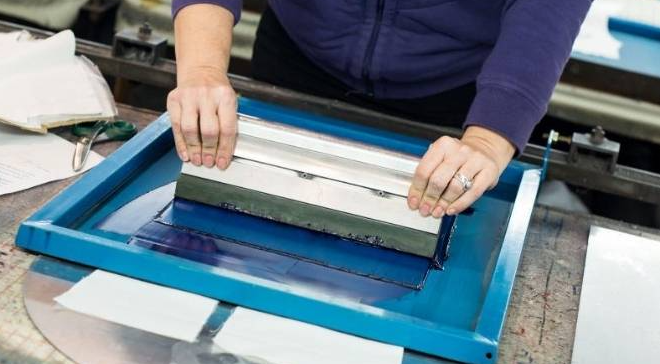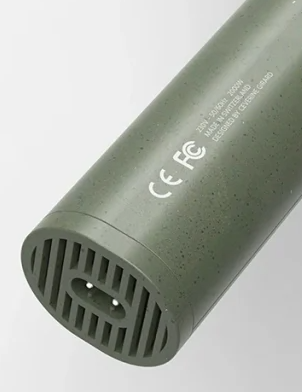Silk Screen Printing on Metal: About How to Print on Metal Parts
 Oct 11,2025
Oct 11,2025

Silk screen printing is not only limited to logos, emblems or designing on clothing. It is an important procedure in metal processing also. However, some of the customers are not really familiar with the process and technical aspects of silk screen printing on metals. This guide will help you to understand the knowledge of silk screen printing and its role in metal fabrication. So let’s dive in!

What Is Silk Screen Printing on Metal?
Silk screen printing on metals is a finishing process. It transfers ink by a stenciled mesh screen to make a printed design on metal. This method has ability to make vibrant, and highly detailed graphics, text and designs that have ability to survive harsh industrial conditions and environments.
What Is Silk Screen vs Screen Printing?
silk-screening and screen printing have the same method. "Silk-screening" is an older term for the method that initially used silk mesh for the stencil. And "screen printing" is the modern and generic name and synthetic materials like polyester are used for mesh. However, the basic method remains the same.
How Screen-Printing Works
Silk screen printing on metal parts and for other materials have the same basic technique but metal needs specific surface preparation and ink types for maximum adhesion and durability.
How Silk Screen Print Works?
silk screen printing techniques originated in ancient times in (960–1279 AD) which them moved to west in 18th century. The process became modernized in 1910 and during 1960s it led to mass production. Silkscreen printing is a stencil-based printing process in which ink is pressed thorough a mesh screen over a metallic surface to transfer a design

What Surfaces Can You Screen Print Onto?
Screen printing is a versatile process and can be applied to any metallic surface including machined parts. But it needs proper surface preparation and selecting specialized inks formulated to bond with the metal and its finish.
What’s Your Ideal Printing Effects on Metal Parts?
There are variety of metals like screen printing on aluminum, stainless steel or cold-rolled steel. Screen printing helps to get aesthetic and functional effects like matte of gloss finish, vibrant or opaque colors, reflective surfaces or textured surfaces.
Screen Print onto Metal Parts
Some of the common metals that are screen printed are as:
1.Screen Printing on Aluminum
screen printing on aluminum grades 5052 and 6061 are common substrates for screen printing. They are lightweight, durable, and corrosion resistant. Their common applications range from branded products to electronic front panels.
2.Screen Printing on Stainless Steel
Stainless steel 304 and 316 are normally screen printed to increase their high corrosion resistance and strength. It is usually for creating durable logos, text, and 3D effects on plaques, covers, and signs on stainless steel.
3.Screen Printing on Cold-Rolled Steel
Cold-rolled steel is screen printed for metal chassis, cabinets, and other industrial parts. This method increases their adhesion and durability, especially for the primed and painted steels.
Metals Unsuitable as Base Metal
Some metals are not suitable as a base for screen printing due to their surface properties that do not provide ink adhesion and durability. For example, sand-cast iron which has uneven surface texture and bare magnesium that is reactive metal and corrodes easily
Screen Print onto Engineering Plastic Parts
It is an effective method to apply graphics and text to many engineering plastics. Plastics have higher mechanical and thermal properties and create durable prints. Examples of screen-printed engineering plastic parts are electronic devices, auto parts and medical devise.

How to Do Surface Preparation and Pretreatments
Surface preparation is important to have good adhesion of coating and paint and to have long lasting coating. Metals need a series of preparation steps for optimal adhesion.
Why Surface Preparation Matters?
If surface is prepared before printing, it can cause premature coating failure and will take time and cost to fix it. Bad effects of dirty or untreated surface would be poor adhesion, corrosion, blistering, uneven finish, and less durability
Steps of Surface Preparation
A general process of surface preparation is:
- Asses the surface and determines the preparation requirements.
- Remove any previous coating, oil or finishing
- Degrease the surface and remove contaminants with acid
- Create a uniform surface with abrasive paper
- Rinse, dry and apply primer on the surface
Printing Inks for Metals
Specialized inks are used in printing on metal. They can create effective bond to a non-porous surface. Epoxy inks are popular due to their high strength and durability. These are best for steel, aluminum, and stainless steel.
The Screen-Printing Process on Metal Parts (Step by Step)
A detailed process of silk screening metal parts is explained below:
What Makes the Process of Silk Screening so Unique?
It is unique screen printing due to having thick ink deposition, versatility to material application, durable, high-quality detail and cost effective for long term on metal screen printing.
Screen Fabrication
Design is created and mesh screen is prepared with the design. Screen is burnt in UV light and stencil created to make design on mesh.
Ink Mixing, Viscosity Control
Inks like solvent-based or epoxy-based inks are formulated and their viscosity is adjusted for smooth printing. Inks are mixed to get precise color.
Registration Setup
Metal part is placed on printing surface and stencil is aligned over the part for printing. For multiple screens, registration marks are used to have precise alignment for each color.
Printing Passes, Squeegee Technique
Ink is poured on screen, and a thin layer is dragged with a squeegee. The process is repeated for multiple colors with different ink on screen.
Flash Cure, Final Bake
After printing colors, metal part is cured and heated at high temperatures in the oven for a specific time. This improves durability and adhesion.
Inspection, Adhesion Tests
Printing is tested visually and then adhesion test according to ASTMD3359 and durability tests are carried out for harsh environments.
Benefits of Silkscreen Printing on Metal Parts
There are many benefits associated with silk screening metal parts. Some of them are:
Suitable for Various Different Metals
It is compatible with a wide range of base metals, like aluminum, stainless steel, copper, brass, and nickel.
Precise Registration for Control Panels
It does precise and repeatable placement of designs. This is a critical element for creating control panels and industrial labels with accurate text and graphics.
High Opacity, High Contrast
It lays down a thick layer of ink which has excellent opacity and transfers vivid colors. This creates high-contrast graphics.
Easy to Customize
It can be used repeatedly and allows for a wide variety of custom colors and special effects like textured finishes.
What’s Bad About Screen Printing?
silk screen printing techniques have few drawbacks, which are:
- High initial setup costs
- Limited fine detail and gradients
- Higher cost for more colors
Screen Printing vs Laser Marking, Pad Printing, and UV Inkjet
A brief comparison of screen printing, laser marking, pad printing and UV inkjet for the convenience of our customers is given below:
Coverage and Color Saturation
A comparison of coverage and color saturation is given below
|
Method |
Coverage and color saturation |
|
Screen printing |
High coverage and vibrant colors. |
|
Laser marking |
monochromatic with strong contrast |
|
Pad printing |
Moderate coverage with specific opacities. |
|
UV inkjet |
High-resolution, full-color images |
Which Is Better for Small Texts or Icons?
a comparison for small text, icons and fine details is as:
|
Method |
Small text and icons |
|
Screen printing |
Not ideal for fine detail |
|
Laser marking |
Excellent for micro-text and codes |
|
Pad printing |
Good for fine text and graphics |
|
UV inkjet |
Excellent for intricate, multi-color designs |
Comparing Cost per Part
A comparison of all four methods for low, mid, and high volumes is as:
|
Volume |
Screen printing |
Laser marking |
Pad printing |
UV inkjet |
|
Low volume |
High cost |
Moderate to high |
Moderate cost |
Moderate cost |
|
Mid volume |
Cost-effective. |
Cost-effective. |
Cost-effective. |
Cost-effective. |
|
High volume |
cost-effective. |
cost-effective. |
cost-effective. |
Moderate cost per part. |
Applications for Screen Printing on Metal Parts
Screen printing on metal is very cost effective and durable. Its common applications are:
Industrial Labels and Rating Plates
It is used for printing safety instructions, operational labels, and warning labels for machinery and industrial items.
Front Panels, Keypads, and Legends
Equipment front panels and membrane keypads have screen-printed graphics and legends for high opacity.
Consumer and Medical Housings
It provides durable and high-contrast markings for consumer electronics and medical device industries.
Custom Metal Parts
Screen printing is versatile and can create custom parts from aerospace components to decorative elements. Contact TUOFA today to bring your metal parts to life with durable, high-quality screen printing.
Conclusion
Silk screen print on metals is creating a design on film, preparing the mesh with light-sensitive emulsion and exposing it to create a stencil. A metal ink is applied that adheres well and cures heat or UV light to the metal surface. It creates durable and wear resistant, chemical and weather resistance printing on metal.
FAQS
Can I screen print on any material?
No, it cannot be printed on any material without adjustments but fabric, paper, wood, metal, plastic can be printed.
Can silkscreen be removed?
Yes, it can be removed by heat and scraping, chemical solvents like acetone, or abrasion with tools.
What should you not do when screen printing?
Do not use a fan directly on your screen and apply uneven squeegee pressure.
 Tel/WeChat:
Tel/WeChat:  Email:
Email: 
 Home
Home
 What Is Finite Element Analysis (FEA)? How Does FEA Works?
What Is Finite Element Analysis (FEA)? How Does FEA Works? 







